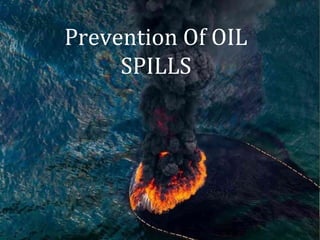
Oilspills 121205234057-phpapp02
- 2. OUTLINE • Oil spill • Causes of oil spill • Effects of oil spill • Major Oil Spills • Various types of Preventions • Methodolgy • Conclusions • References
- 4. Causes of Oil Spills • Sinking or leakage of Oil carrying vessels or Oil pipelines • Illegal dumping by industries • Countries at war • Terrorist activities • Natural Disasters
- 5. • Effects entire marine life • Blocks entrance of oxygen in water • Fishes hatch with twisted spines and deformed hearts • Effects the food web when oil reaches sea bed • Natural recovery process may require upto 10 years Effects of Oil Spills
- 6. Major Oil Spills • Arabian Gulf Spills (1991) Location – Persian Gulf Cause – terminals and oil tankers destroyed Quantity of oil spilled – 6 to 8 million barrels • Exxon Valdez Oil Spill (1989) Location – Alaskan waters Cause – Ship wreckage Quantity of oil spills – 260,000 barrels • Gulf Oil Spill (2010) Location - Gulf of Mexico Cause - oil well below the gulf blew out Quantity – 260 million gallons
- 7. PREVENTIONS • Double-hulling - build double hulls into vessels, which reduces the risk and severity of a spill in case of a collision or grounding. Existing single- hull vessels can also be rebuilt to have a double hull. • Secondary containment - methods to prevent releases of oil or hydrocarbons into environment. • Blowout Preventer • Well castings
- 8. Making shipping safer • Ship crew must be well trained and experienced • Strict fire safety regulations apply on board • Individual tanks within ships should be limited in size so that spills are smaller • Vessel traffic control to be used in more congested areas to reduce the risk of collision
- 9. Keeping the navigator informed • Up to date information on changing weather conditions • Interpretation of radar and satellite image reports for sensitive coastal areas and inland water routes • Computer based video-display that allows navigators to track the ship course in relation to hazards and warns the navigator • Monitoring and control equipment on ships; discharged oil-water mixtures can be traced back to the ship that was carrying the oil
- 10. Methodology There are a number of methods which may apparently be used to deal with oil spills in seawater. Some options used for marine protection from oil pollution include: •Mechanical Collection •Chemical Dispersants •Naturally available materials
- 11. By mechanical collection • Setting fire to the oil spill: Frequently crude oil is set on fire in a wrecked ship when an accident occurs. The problem of burning surface oil is very difficult due to less thickness of the layer and large surface area. The volatile fraction evaporates quickly and makes it impossible to ignite without doping special measures. • Skimming: It can be performed by employing devices for collecting oil from a large area of water to make it a thicker layer in harbour sheltered places.
- 12. By Chemical Dispersants • Sinking: Mixing small fine granular solids of fairly high density (sand) culminates into slurry, sinking the oil spill to the bottom of the seabed. • Absorbing: Floating oil can be separated due to absorption applying chemicals. • Gelling: Spraying gelling agents with a certain amount of mixing energy into the oil spill causes formation of gel or coagulation. The resulting lumps can be collected easily in the vicinity of a wrecked ship.
- 13. By using naturally available materials CORCHORUS DEPRESSUS - This plant acts as a sinking material when used in the powder form for removal of oil from seawater by absorbing oil and settling to the bottom. ARACHIS HYPOGAEA - The solid pulp that remains after edible oil is extracted from it as a high protein live stock feed which enables it to absorb the oil spill from sea water which gets collected on the surface.
- 14. BENTONITE CLAY: It acts as a sinking material when added to oil spill polluted water sample ACTIVATED CARBON: This material causes the oil spill to form a gel or coagulate, however due to its chemical composition it may have negative side effects on marine health life environment
- 15. CONCLUSION • Most oil spills and most serious accidents are caused by human error, so this can be reduced if one takes extreme precautions and proper safety assessments • Focusing on many techniques such as Blowout preventer and well castings can contain the oil spill • Use of naturally available materials such as CORCHORUS DEPRESSUS, ARACHIS HYPOGAEA, BENTONITE CLAY & ACTIVATED CARBON helps containing the spill
- 16. REFERENCES • Oil Spill http://en.wikipedia.org/wiki/Oil_spill • Major Oil Spills http://www.mnn.com/earth-matters/wilderness- resources/stories/the-13-largest-oil-spills-in-history • Spill response – dispersants kill fish, journal Environmental Toxicology and Chemistry. Retrieved 2010-05-21. • Dr. Brian Dicks (1998), Paper presented at the International Seminar on Tanker Safety, Pollution Prevention, Spill Response and Compensation, Rio de Janeiro, Brazil